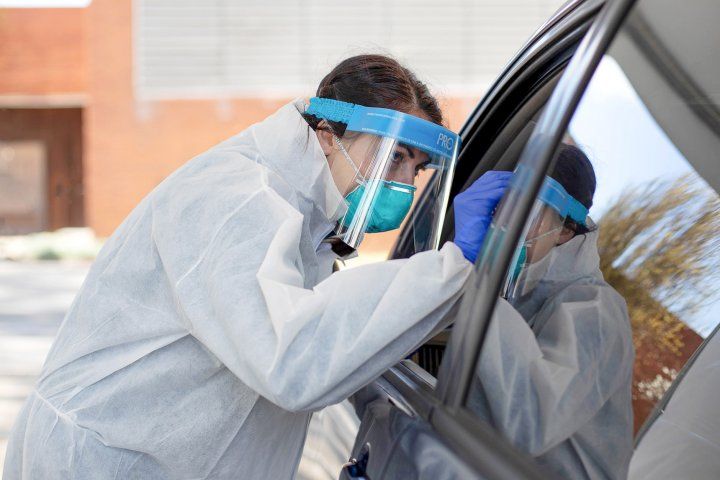As Mask Shortages Loom, Nationwide Team Assembles Best Practices for Decontamination and Reuse
‘N95Decon’ Initiative Offers New Web Clearinghouse for Health Officials

Kelly Brothers, RN, a nurse at UCSF wears an N95 mask and face shield while testing a person for COVID-19. Photo by Susan Merrell
As health workers and first responders try to stem a pandemic without an adequate supply of protective gear, health officials are being forced to consider a stopgap measure – decontaminating and reusing the N95 masks that frontline caregivers use as protection against the virus that causes COVID-19.
To provide these officials with a set of best practices for mask decontamination, a nationwide team of 60 scientists and engineers, students and clinicians, drawn from universities and the private sector, have launched N95decon.org, a website that distills a broad range of relevant scientific literature.
“The scientific volunteers who made this happen came together in this time of crisis to help workers and administrators make informed decisions about N95 decontamination and create standard operating procedures based on their own specific circumstances,” said Hana El-Samad, Kuo Family Professor and vice chair of Biochemistry and Biophysics at UC San Francisco, who helped organize the ad hoc team of scientists along with Manu Prakash, PhD, associate professor of bioengineering at Stanford University, and Kevin Fu, PhD, associate professor of computer science and engineering at the University of Michigan.
At UCSF, El-Samad was joined in the N95decon effort by David Rempel, MD, MPH, emeritus professor of medicine (also emeritus professor of bioengineering at UC Berkeley), and David Robinowitz, MD, MHS, professor of medicine.
The team members, who assembled in matter of weeks, scoured hundreds of peer-reviewed publications, and held continuous online meetings to review studies of three decontamination methods that had been used on previous viral and bacterial pathogens. They then assessed the potential for these methods to be used on the novel SARS-CoV-2 virus that causes COVID-19.
The three methods the team focused on involve using heat and humidity; a specific wavelength of light called ultraviolet C (UVC); and hydrogen peroxide vapors (HPV). Margaret Gardel, PhD, the Horace B. Horton Professor of Physics at the University of Chicago, led the analysis of techniques using heat; Amy E. Herr, PhD, professor of engineering at UC Berkeley, led the UVC portion of the project; and Jill R. Crittenden, PhD, a research scientist at MIT’s McGovern Institute for Brain Research and Koch Institute for Cancer Research, covered methods involving HPV.
The goal was to provide overwhelmed health officials without the time or expertise to study this literature for themselves with reliable, “predigested” scientific information on the pros and cons of each of the three decontamination methods to offer the best options should local mask shortages force a choice between reusing masks or working without them.
“While there is no perfect method for decontamination of N95 masks, it is crucial that decision-makers and users have as much information as possible about the strengths and weaknesses of various approaches,” said Prakash. “We aim to provide information and evidence in this critical time to help those on the front lines of this crisis make risk-management decisions given the specific conditions and limitations they face.”
The scientists do not endorse any one method but instead aimed to describe the particular circumstances under which each might be effective against, provided rigorous procedures are followed. Devices that rely on heat, for instance, could be effective using specific temperature, humidity, and time parameters. With devices that emit UVC light, additional considerations come into play, such as making sure masks are properly oriented to the light so the entire surface is bathed in sufficient energy. The HPV method has the potential advantage of decontaminating many masks at once; the U.S. Food and Drug Administration, acting in this emergency, has certified certain vendors to offer HPV treatments on a large scale.
“I think there's a lot of uncertainty among the health care systems on the science behind different decontamination methods,” Fu said. “We provide a rigorous scientific assessment to reduce the uncertainty. There is no perfect method. Decision-makers need to make their own choices given their local circumstances and conditions.”
Coincident with the launch of the N95decon website, the U.S. Centers for Disease Control and Prevention (CDC) released a data-driven fact sheet and detailed overview for implementing each of these three recommended methods. N95decon.org will help facilitate the rapid deployment of these emergency measures by pointing decision makers to sources of reliable and detailed how-to information provided by other organizations, institutions, and commercial services.
The researchers stress that decontamination will not solve the N95 shortage, and expressed the hope that new masks will be made available in large numbers as soon as possible, so that health care workers and first providers can be issued fresh protective gear whenever needed, as set forth in non-emergency CDC guidelines.
Meanwhile, N95decon team will continue working together to update the N95decon.org website as new information becomes available, and to do efficient, coordinated research to plug the gaps in current knowledge on mask decontamination.
In addition to those from UCSF, Stanford, Michigan, MIT, Chicago, and UC Berkeley, the N95decon team has members at Georgetown University, Harvard University, the University of Seattle, and the University of Utah, as well as from Consolidated Sterilizers and X, the Moonshot Factory.
The University of California, San Francisco (UCSF) is exclusively focused on the health sciences and is dedicated to promoting health worldwide through advanced biomedical research, graduate-level education in the life sciences and health professions, and excellence in patient care. UCSF Health, which serves as UCSF’s primary academic medical center, includes top-ranked specialty hospitals and other clinical programs, and has affiliations throughout the Bay Area.